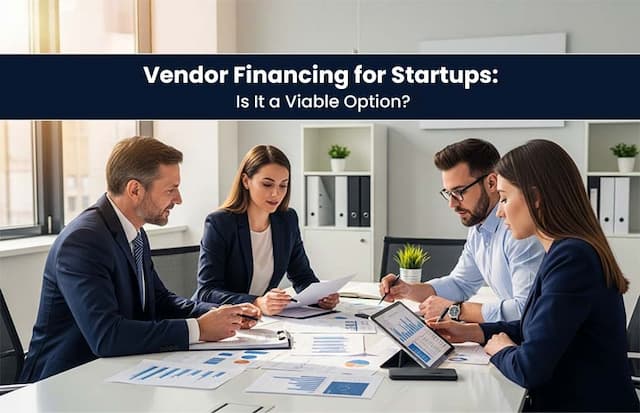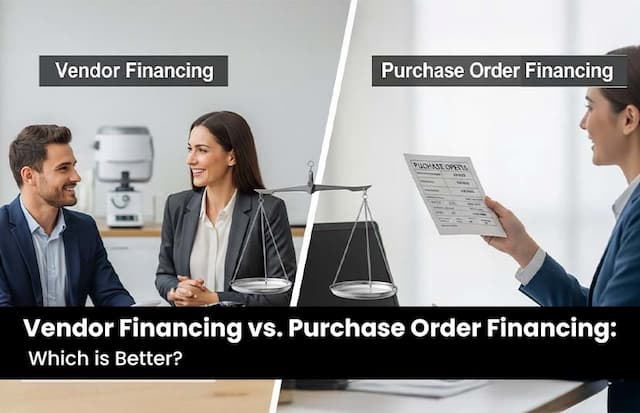For the sustainability and profitability of any business, it must grow and expand. However, insufficient funds could be a major challenge for businesses, especially small firms. In such cases, funding options like Vendor Financing become an option to infuse immediate funding and meet the operational requirements.
The guide below is all about vendor financing to help readers thoroughly understand what it’s all about and make an informed choice.
Key Takeaways:
- Vendor financing is a financial agreement between a business owner and the vendor, where the latter provides credit to the business to buy goods and services at a mutually agreed interest rate.
- There are two main types of Vendor financing: The first one is debt financing, where the borrower has to pay interest to the vendor. The second one is equity financing, where the borrower pays through the company’s shares.
- Vendor financing is a great opportunity for small businesses to deal with a cash crunch and optimize operations.
- Interest charges and collateral requirements in vendor financing may vary based on the mutual agreement.
- When opting for vendor financing, it is very important that you compare options, build a strong relationship with the vendor, negotiate terms, assess financial conditions, and understand the agreement thoroughly.
What is Vendor Finance?
Vendor Financing, sometimes also referred to as Trade Credit or Supplier Finance, is a financial term that’s used to describe the financial arrangement between a vendor and a business owner. In this type of arrangement, the vendor lends money to the business, which, in turn, employs the same fund to buy goods and services from the same vendor.
“Have a look at this interesting fact before you proceed: In business, the use of credit in vendor finance is called an “open account.”
In all cases, or most cases, Vendor Financing is the deferred credit* for the entity. Why? Because customers do not pay upfront for the purchase they make. They can do it after the sale of the products.
* Deferred credit is a company’s income that has not been fully earned yet. It’s like an employee getting paid for a job that he/she hasn’t finished yet. That’s your income but you cannot claim it before you complete the task.
When compared with traditional bank loans, Vendor Financing can carry comparably higher interest rates, and the borrower may have to present some collateral against the loan. Depending on how well customers are known in the market and their relationship with the vendor, they may receive funds without any interest charges based on an agreement.
Types Of Vendor Financing
There are broadly two types of vendor financing that you need to understand:
1. Debt Financing
Debt financing is a financing option where the receiver can get goods and services at a discounted price and, in return, has to pay interest at a rate decided by the vendor company. With every installment settled, vendors earn interest.
What if the receiver fails to pay the vendor? He/she is marked as a defaulter.
The amount owed by the customer is considered as a loss and recorded under ‘bad debts.’
2. Equity Financing or Inventory Financing
Under this type of vendor financing, the receiver gets to buy goods and services from the vendor in exchange for a defined number of shares. In simple terms, the buyer doesn’t have to pay the vendor in cash; rather, the payment is settled in share units.
It means that the vendor now becomes a shareholder of the company and is liable to receive dividends on the shares they hold. The higher the shares, the more control the vendor gets to share with the company’s management. Mostly, small businesses opt for such a financial arrangement.
How Does Vendor Financing Work?
In the financial arrangement made under vendor financing, the borrower pays the vendor the initial deposits as per the vendor’s terms and conditions. Now, the borrower is liable to pay the rest of the amount within the timeframe set by the vendor. The payment may or may not include interest, but both the purchase price and the repayment amount are much higher than typical credit payments. In case of the interest imposed, the rate is fixed after both parties mutually agree to the terms and conditions.
Most of the time, businesses go for vendor financing as their last option when they are unable to fulfill the lending requirements set by the financial institutions.
An Example of Vendor Financing
To help you better understand the concept of vendor financing, here’s an example to understand the process:
Assume there’s a manufacturing company called Moons Limited, and it has to buy raw materials worth Rs. 1 lakh from a vendor called Tejas. Now, Moons Limited is facing some financial issues, and it can only pay 40,000 for the raw materials it has to buy from Tejas. Now, Moons Limited has a good credit history, and based on that, Tejas agrees to supply raw material worth 1 Lakh after taking 40,000 from Moons Limited. He gives the company a written note that includes details of the transaction and the agreed-upon terms.
Now, as per the terms mutually agreed upon by both parties, the vendor decided to charge 10% on the remaining amount, which was 60,000. This was the financial arrangement based on which Moons Limited could get raw materials from Tejas. Moons Limited can pay back the remaining amount to Tajas in installments, along with the 10% interest rate.
This is how the entire arrangement of Vendor Financing takes place with its own set of pros and cons.
Benefits of Vendor Financing For Vendors
Understand how vendor financing is beneficial for vendors:
1. Control Over Loan Approval: With vendors getting the final say in approving loans for the borrowers, they have the liberty to manage their bad debt risk effectively.
2. Interest Income: Vendors get to earn interest on the loan amount, which leads to a revenue boost.
3. Steady Income Stream: Vendor finance provides vendors with a predictable and steady flow of funds over the repayment period.
4. Increased Sales: Last but not least, it increases the sales of vendors when borrowers buy goods and services from the same vendors.
Benefits of Vendor Financing For Borrowers
Understand how vendor financing is beneficial for borrowers:
1. Uninterrupted Production: Vendor financing makes sure that the business enjoys uninterrupted production, leading to more revenue generation and profits.
2. Swift Repayment: Borrowers have the liberty to quickly repay the loan amount from the profit earned and uninterrupted production.
3. Optimized Production and Higher Returns: Access to funds allows businesses to optimize processes and increase returns on investment.
4. Easy Access to Non-Qualifiers of Traditional Loans: Even businesses that are not eligible for traditional loans can get vendor financing.
Tips on How To Get Started With Vendor Financing?
We understand that Vendor Financing can be a last-minute escape to bridge the gap for unexpected financial requirements, but to lay the foundation for success and get the most benefits from it, you must take the right steps while opting for vendor financing. These tips below will definitely help you:
- Even if you need to opt for vendor financing on an urgent basis, the benefits of comparing your options can’t be emphasized enough. Understanding the interest rates, terms, and conditions of different options is a must to settle on the best one.
- Always try to build a strong relationship with the vendor before going for financing. A good relationship can end up with some good negotiation terms.
- Never hesitate to bend the financing terms and bring them to your terms if you can. Most of the time, the vendors are open to negotiation.
- Understand and evaluate your financial conditions well in advance to make sure that you will be able to meet the repayment terms without your budget being hampered.
- Carefully read and understand the terms and conditions. If needed, take help from professionals to better understand what you are signing up for and avoid future shocks.
What Are the Different Types of Vendors?
Vendors are available in so many types, such as payroll management companies, security firms, maintenance service providers, and others. B2B suppliers, such as equipment manufacturers, often offer vendor financing. Materials and parts suppliers also provide vendor financing services.
Credlix is also emerging as a leading player in the vendor financing ecosystem. To strengthen small businesses, Credlix offers comprehensive and efficient vendor financing solutions tailored to meet the unique financial needs of each enterprise.
FAQs
1. Who is a vendor?
A vendor can be anyone who sells goods and services. It can be a business owner, an entity, or the government.
2. How much credit can one receive from Vendor Financing?
How much credit one can receive from Vendor Financing is very different from the traditional loan or financial agreement that businesses avail. It mainly depends on the agreement the two parties have entered into.
3. What is a vendor note?
A vendor note is a short-term loan from a vendor to a customer, secured by purchased goods. It’s a form of vendor finance, offering deferred loans.
4. Is Vendor Financing a good idea?
Vendor financing is a very good option for small businesses suffering from capital constraints, and don’t wish to go for traditional loans.
5. Is some collateral required to avail of Vendor Financing?
Based on the agreement, the borrower may be required to pledge some assets as collateral to avail of vendor financing
6. When should one go for Vendor Financing?
Businesses should go for vendor financing when they are falling short of capital to purchase goods or services to meet their production requirements. Also, businesses that can’t opt for traditional financing, like loans, find Vendor Financing a feasible choice.





